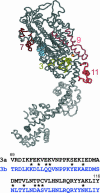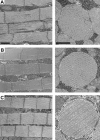Alternative N-terminal regions of Drosophila myosin heavy chain tune muscle kinetics for optimal power output
- PMID: 15345559
- PMCID: PMC1304585
- DOI: 10.1529/biophysj.103.032078
Alternative N-terminal regions of Drosophila myosin heavy chain tune muscle kinetics for optimal power output
Abstract
We assessed the influence of alternative versions of a region near the N-terminus of Drosophila myosin heavy chain on muscle mechanical properties. Previously, we exchanged N-terminal regions (encoded by alternative exon 3s) between an embryonic (EMB) isoform and the indirect flight muscle isoform (IFI) of myosin, and demonstrated that it influences solution ATPase rates and in vitro actin sliding velocity. Because each myosin is expressed in Drosophila indirect flight muscle, in the absence of other myosin isoforms, this allows for muscle mechanical and whole organism locomotion assays. We found that exchanging the flight muscle specific exon 3 region into the embryonic isoform (EMB-3b) increased maximum power generation (P(max)) and optimal frequency of power generation (f(max)) threefold and twofold compared to fibers expressing EMB, whereas exchanging the embryonic exon 3 region into the flight muscle isoform (IFI-3a) decreased P(max) and f(max) to approximately 80% of IFI fiber values. Drosophila expressing IFI-3a exhibited a reduced wing beat frequency compared to flies expressing IFI, which optimized power generation from their kinetically slowed flight muscle. However, the slower wing beat frequency resulted in a substantial loss of aerodynamic power as manifest in decreased flight performance of IFI-3a compared to IFI. Thus the N-terminal region is important in tuning myosin kinetics to match muscle speed for optimal locomotory performance.
Figures






Similar articles
-
An alternative domain near the ATP binding pocket of Drosophila myosin affects muscle fiber kinetics.Biophys J. 2006 Apr 1;90(7):2427-35. doi: 10.1529/biophysj.105.075184. Epub 2006 Jan 6. Biophys J. 2006. PMID: 16399836 Free PMC article.
-
Alternative versions of the myosin relay domain differentially respond to load to influence Drosophila muscle kinetics.Biophys J. 2008 Dec;95(11):5228-37. doi: 10.1529/biophysj.108.136192. Epub 2008 Sep 19. Biophys J. 2008. PMID: 18805920 Free PMC article.
-
Alternative N-terminal regions of Drosophila myosin heavy chain II regulate communication of the purine binding loop with the essential light chain.J Biol Chem. 2020 Oct 16;295(42):14522-14535. doi: 10.1074/jbc.RA120.014684. Epub 2020 Aug 19. J Biol Chem. 2020. PMID: 32817166 Free PMC article.
-
Determining structure/function relationships for sarcomeric myosin heavy chain by genetic and transgenic manipulation of Drosophila.Microsc Res Tech. 2000 Sep 15;50(6):430-42. doi: 10.1002/1097-0029(20000915)50:6<430::AID-JEMT2>3.0.CO;2-E. Microsc Res Tech. 2000. PMID: 10998634 Review.
-
C-terminal isoforms of the myosin heavy chain and smooth muscle function.Comp Biochem Physiol B Biochem Mol Biol. 1997 May;117(1):3-11. doi: 10.1016/s0305-0491(96)00308-2. Comp Biochem Physiol B Biochem Mol Biol. 1997. PMID: 9180009 Review.
Cited by
-
An exceptionally fast actomyosin reaction powers insect flight muscle.Proc Natl Acad Sci U S A. 2006 Nov 14;103(46):17543-7. doi: 10.1073/pnas.0604972103. Epub 2006 Nov 3. Proc Natl Acad Sci U S A. 2006. PMID: 17085600 Free PMC article.
-
The load dependence of muscle's force-velocity curve is modulated by alternative myosin converter domains.Am J Physiol Cell Physiol. 2019 Jun 1;316(6):C844-C861. doi: 10.1152/ajpcell.00494.2018. Epub 2019 Mar 13. Am J Physiol Cell Physiol. 2019. PMID: 30865518 Free PMC article.
-
Five Alternative Myosin Converter Domains Influence Muscle Power, Stretch Activation, and Kinetics.Biophys J. 2018 Mar 13;114(5):1142-1152. doi: 10.1016/j.bpj.2017.12.045. Biophys J. 2018. PMID: 29539400 Free PMC article.
-
The mechanical properties of Drosophila jump muscle expressing wild-type and embryonic Myosin isoforms.Biophys J. 2010 Apr 7;98(7):1218-26. doi: 10.1016/j.bpj.2009.11.051. Biophys J. 2010. PMID: 20371321 Free PMC article.
-
An embryonic myosin converter domain influences Drosophila indirect flight muscle stretch activation, power generation and flight.J Exp Biol. 2014 Jan 15;217(Pt 2):290-8. doi: 10.1242/jeb.091769. Epub 2013 Oct 10. J Exp Biol. 2014. PMID: 24115062 Free PMC article.
References
-
- Babu, G. J., E. Loukianov, T. Loukianova, G. J. Pyne, S. Huke, G. Osol, R. B. Low, R. J. Paul, and M. Periasamy. 2001. Loss of SM-B myosin affects muscle shortening velocity and maximal force development. Nat. Cell Biol. 3:1025–1029. - PubMed
-
- Bernstein, S. I., and R. A. Milligan. 1997. Fine tuning a molecular motor: the location of alternative domains in the Drosophila myosin head. J. Mol. Biol. 271:1–6. - PubMed
-
- Bernstein, S. I., K. Mogami, J. J. Donady, and C. P. Emerson, Jr. 1983. Drosophila muscle myosin heavy chain encoded by a single gene in a cluster of muscle mutations. Nature. 302:393–397. - PubMed
-
- Blanchard, E. M., K. Iizuka, M. Christe, D. A. Conner, A. Geisterfer-Lowrance, F. J. Schoen, D. W. Maughan, C. E. Seidman, and J. G. Seidman. 1997. Targeted ablation of the murine alpha-tropomyosin gene. Circ. Res. 81:1005–1010. - PubMed
-
- Burghardt, T. P., A. R. Cruz-Walker, S. Park, and K. Ajtai. 2001. Conformation of myosin interdomain interactions during contraction: deductions from muscle fibers using polarized fluorescence. Biochemistry. 40:4821–4833. - PubMed
Publication types
MeSH terms
Substances
Grants and funding
LinkOut - more resources
Full Text Sources
Molecular Biology Databases

